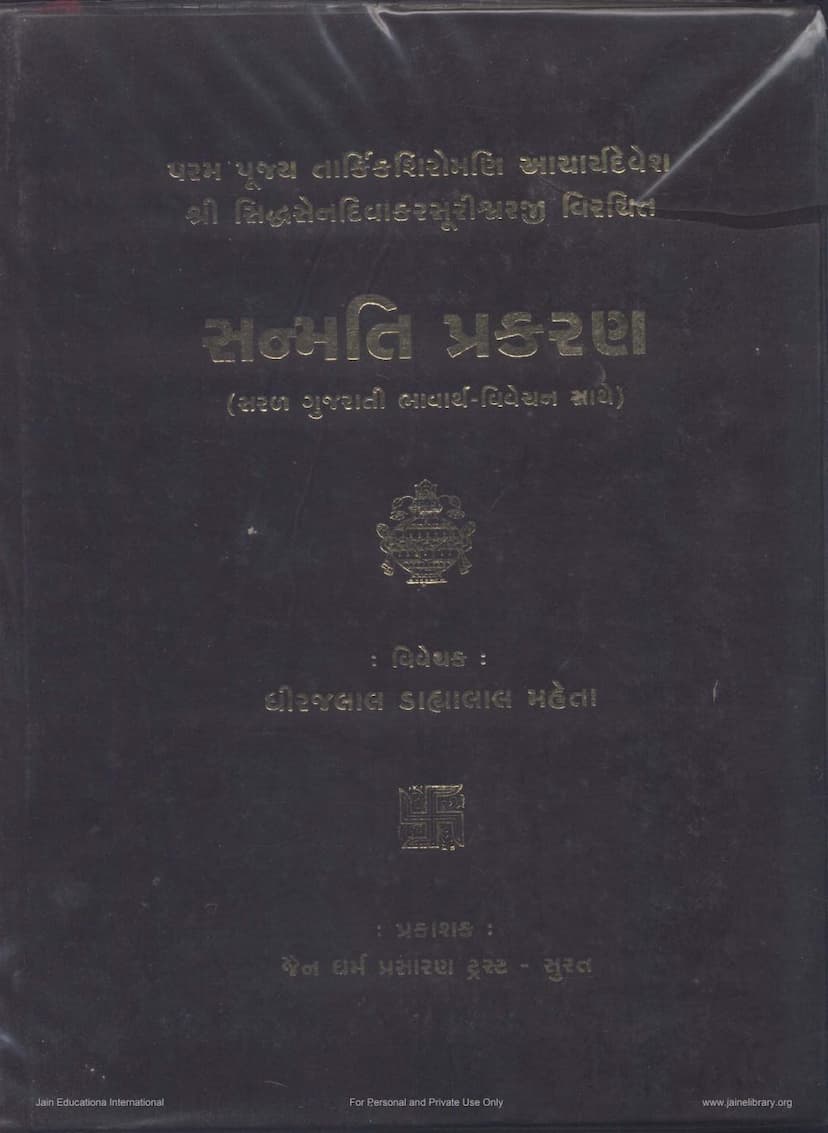Sanmati Prakaran
Added to library: September 2, 2025

Summary
This document is a comprehensive summary in English of the Jain text "Sanmati Prakaran" by Dhirajlal D. Mehta, published by Jain Dharm Prasaran Trust, Surat.
The text is a detailed exposition of the "Sanmati Prakaran" (also known as "Sanmati Tark") by Acharya Shri Siddhasen Divakar Surishwarji. The summary covers various aspects of the book, including its background, author's life and works, the content of "Sanmati Prakaran," and its significance in Jain philosophy.
Key aspects covered:
- Introduction and Background: The text highlights the importance of India as the land of Aryans and the birthplace of numerous spiritual figures, including Jain monks and philosophers. It contrasts the materialistic nature of Western countries with India's spiritual wealth.
- Jain Philosophy vs. Other Philosophies: The summary emphasizes the supremacy of Jainism, established by the omniscient Tirthankaras, over other philosophical systems whose founders are considered fallible and possess incomplete knowledge. Jainism's core principle of Anekantavada (non-one-sidedness) is presented as its unique strength in understanding the multifaceted nature of reality.
- Author's Life and Works: It discusses the esteemed author, Acharya Shri Siddhasen Divakar Surishwarji, recognizing him as a prominent scholar and a victor in philosophical debates. The text delves into the challenges of pinpointing his exact time period, citing various scholarly opinions and historical references that place him around the 4th-5th century CE, while acknowledging the tradition that links him to King Vikramaditya. His other known works like "Nyayavtar" and "Kalyanmandir Stotra" are also mentioned.
- Content of Sanmati Prakaran: The book is structured into three kandas (sections) with a total of 166 gathas.
- First Kanda: Focuses on the Dravyardhik and Paryayarthik Nayas (perspectives) and explains how all phenomena in the universe possess both general and specific characteristics. It elaborates on the concepts of Dravya (substance) and Paryay (mode) as fundamental to understanding reality.
- Second Kanda: Addresses the debate on the usage of Keval-gyan (omniscience) and Keval-darshan (omniscience vision) by Kevalis (omniscient beings). It discusses whether their usage is sequential, simultaneous but distinct, or simultaneous and unified (Abhed-upayog).
- Third Kanda: Primarily deals with Anekantavada, critiquing other philosophical schools (like Buddhism, Sankhya, Mimansa, Nyaya) for their one-sided views and demonstrating the superiority of the multifaceted Jain perspective. It also includes insightful aphorisms for ethical conduct and spiritual upliftment.
- Language and Style: The "Sanmati Prakaran" is written in pure Prakrit, eschewing Sauraseni or Paishachi dialects. The gathas are said to be profound, with their meaning becoming evident through contemplation.
- Commentaries: The text mentions the significant commentary by Abhaydev Suri, known as "Tattvabodh Vidhayini" or "Vadmaharnav," which is extensive and renowned for its philosophical depth.
- Significance: The summary underscores the "Sanmati Prakaran" as a foundational text for understanding Jain philosophy, particularly Anekantavada. Its influence on subsequent Jain scholars is highlighted.
- The Present Commentary: The commentary by Dhirajlal D. Mehta aims to make this complex philosophical work accessible to a wider audience through a simple Gujarati translation and explanation, making it a valuable resource for Jain students and scholars.
In essence, the "Sanmati Prakaran," as presented through this summary and commentary, is a profound philosophical treatise that aims to illuminate the core principles of Jainism, particularly its emphasis on Anekantavada, and to guide readers towards spiritual understanding and liberation.